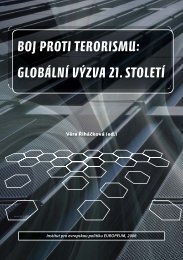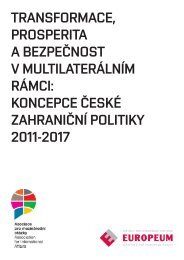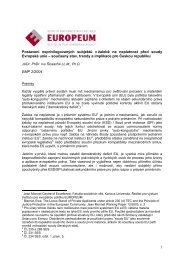eu constitutionalisation - EUROPEUM Institute for European Policy
eu constitutionalisation - EUROPEUM Institute for European Policy
eu constitutionalisation - EUROPEUM Institute for European Policy
You also want an ePaper? Increase the reach of your titles
YUMPU automatically turns print PDFs into web optimized ePapers that Google loves.
Chapter 7: Flexible Integration in the Common Foreign and Security <strong>Policy</strong>in the Draft Constitution by overcoming the existing constraints of enhancedcooperation. Furthermore specific instruments governing closer, structuredand armament cooperation found their way into the Constitution. Thesenewly created mechanisms significantly increase the range of possibilities toact, as well as the degree of complexity.Against the background of a selective analysis of existing <strong>for</strong>ms of flexibilitythis contribution intends to elaborate on the instrument of enhancedcooperation and the newly shaped specific mechanisms of flexible integration.On the basis of both, the Treaty of Nice and the Treaty establishinga Constitution <strong>for</strong> Europe of 18 July 2004 (CIG 87/04), these instrumentsshall be analysed from a legal perspective. In order, to complete the picturescenarios of factual and potential cooperation outside the Treaty frameworkshall be equally taken into consideration. It will be shown in the end, thatthe range of options, starting from (ad-hoc) mechanisms in the frameworkof enhanced cooperation going to new <strong>for</strong>ms of pre-defined and evenpermanent flexibility are promising to boost the profile of CFSP and ESDP.However, whether they will effectively contribute to and urge the integrationprocess is up to future practice. In the following two examples ofexisting <strong>for</strong>ms of Treaty-based flexibility shall be assessed in more detail.II. EXAMPLES OF FLEXIBLEINTEGRATION IN THE CFSPA. Constructive abstention (Article 23 para. 1 TEU)The instrument of constructive abstention allows single member statesto abstain from voting in the framework of CFSP without hamperingthe unanimous decision making process. Thus it is designed to providea flexible alternative to fully blocking decisions requiring unanimity. Withreference to Article 23 para 1 TEU a member state is authorised to makea <strong>for</strong>mal declaration, which means that it will not have to apply the decision,while accepting that the Union as such is bound by it. The respectivemember state is also obliged, in a spirit of mutual solidarity to „refrain fromany action likely to conflict with or impede Union action based on that decision andthe other member states shall respect its position.“ If member states that count <strong>for</strong>242Chapter 7: Flexible Integration in the Common Foreign and Security <strong>Policy</strong>more than one third of the weighted votes, take recourse to constructiveabstention, a decision does ipso iure not materialise.When it appeared in the treaty of Maastricht <strong>for</strong> the first time, it was welcomedas an adequate remedy to the rigid principle of unanimity in the CFSP.Nonetheless, its existence encapsulates a general dilemma. Any application ofconstructive abstention by one or more member states reveals the ostensiblelack of approval with regard to specific matters in this field. In turn a majorityof at least two thirds of the weighted votes is required <strong>for</strong> successful decision-making.Constructive abstention is not so much a potential measure offlexibility than a more organisational element of decision making. Moreover,it is not designed as a general escape clause <strong>for</strong> cases of conflict betweenUnion law and national politics. To illustrate this concern, one may evokethe scenario of a n<strong>eu</strong>tral country which tries to generally avoid its participationin the field of ESDP by taking recourse to constructive abstention. Suchan approach would not only run counter the comprehensive acceptance ofthe acquis as signed at the moment of accession to the Union, but it wouldalso infringe both the solidarity clause enacted in Article 11 para 2 TEU andthe principle of good faith as fundamental principle of international publiclaw. However it must be emphasised, that any member state which cannotor does not want to agree with a decision requiring unanimity is not obligedto make use of constructive abstention. It never <strong>for</strong>egoes its right to preventsuch a decision by using a veto.¹⁵The constitutional treaty equally adopted the option of constructive abstention.However, the wording slightly changed, clearly illustrating the generalendeavour to link voting majorities with quantitative thresholds. Thus in otherwords, a decision shall not be adopted if “the members of the Council qualifyingtheir abstention in this way represent at least one third of the member states comprisingat least one third of the population of the Union” (Article III-300 para 1 TCE).B. Opting out by DenmarkIn the course of the negotiation following the signing of the treaty ofMaastricht, which was refused by the population of Denmark in a popularreferendum, Denmark was granted a specific opting-out clause enacted in the15) See Council of the <strong>European</strong> Union, Decision making and constructive abstention in defence matters,30.08.2001, Doc. 11377/01.243








